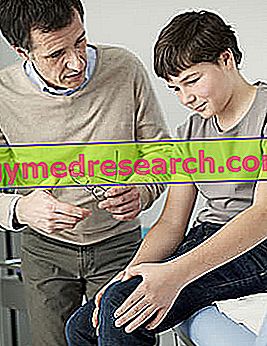Generality
Herpetic stomatitis is an inflammatory pathology of viral origin that involves the oral cavity.

The person responsible for the onset of herpetic stomatitis is the same virus responsible for herpes labialis, or Herpes simplex .
Herpetic stomatitis is a disorder that can occur in children and adults, indifferently affecting both male and female individuals.
What is that?
What is herpetic stomatitis?
Herpetic stomatitis is a particular form of stomatitis that develops on the oral cavity following the contraction of an infection supported by Herpes simplex virus type 1 ( HSV-1 ).
Being a viral condition, herpetic stomatitis is contagious and can therefore be transmitted from the patient to a healthy individual; just as it can be transmitted from the oral cavity to other body areas (nose, eyes, etc.).
The lesions that characterize herpetic stomatitis involve the inside of the mouth and can occur on the whole mucosa of the oral cavity (inner part of the cheeks and lips), on the tongue, on the hard palate and even on the gums (in these cases, yes speaks more correctly about herpetic gingivostomatitis ).
Please note
Herpetic stomatitis should not be confused with aphthous stomatitis, a particular type of stomatitis characterized by the appearance of canker sores within the oral cavity. Unlike herpetic stomatitis, however, aphthous stomatitis is not contagious and usually does not involve the gums and the hard palate.
Causes
What are the Causes and Risk Factors of Herpetic Stomatitis?
As mentioned, herpetic stomatitis is caused by a viral infection sustained by Herpes simplex virus type 1. To be clear, it is the same virus that can give rise to the much known and annoying cold sores.
HSV-1 infection can be contracted by direct or indirect contact with a sick individual. For example, through kissing, or through the mixed use of objects used for oral and personal hygiene care (toothbrushes, towels, etc.).
Among the risk factors that undoubtedly predispose to the contraction of the viral infection, there is the weakening of the immune system or - as happens in children - the incomplete development of the same.
Did you know that ...
Once the infection with the Herpes simplex virus type 1 has occurred, it can no longer be eliminated from the patient's body, even after drug treatment. Although the clinical manifestations of the infection sustained by it can be controlled, HSV-1 remains latent, usually located at the level of the dorsal ganglia, such as, for example, in correspondence with the sensory ganglia of the trigeminal nerve.
In particular conditions, however, the virus is able to reactivate itself giving rise to a new infection.
In this regard, it has been estimated that at least 90% of adult individuals latently host Herpes simplex virus type 1.
In most cases, herpetic stomatitis is contracted in the pediatric age (1-4 years) or, possibly, in adolescence. From that moment on, the virus remains inside the body and can remain latent for long periods (sometimes, even for the whole life span of the patient), or it can occasionally reactivate, giving rise to cyclic infections ( recurrent herpetic stomatitis ) .
Factors That Promote HSV-1 Reactivation
Although once arrived at adulthood, herpetic stomatitis tends to occur less frequently, in certain situations and particular conditions the virus can give rise to new infections.
The exact mechanism leading to the reactivation of HSV-1 has not yet been fully clarified; however, the main factors that may favor this phenomenon seem to be:
- Periods of high stress, both physical and emotional;
- Weakening of the immune system;
- Intake of certain types of drugs, such as, for example, corticosteroids and immunosuppressants.
In addition to what has been said so far, the reactivation of Herpes simplex virus 1 has also been associated with trauma, excessive exposure to ultraviolet rays, exposure to very high or very low temperatures, alterations and modifications of normal hormonal levels (as can occur, for example, during pregnancy or during the menstrual cycle).
Types of Herpetic Stomatitis
Basically, there are two different types of herpetic stomatitis: primary and secondary.
Primary Herpetic Stomatitis
One speaks of primary herpetic stomatitis when the individual comes into contact for the first time with the Herpes simplex virus type 1 developing the inflammation of the oral cavity in question.
Since primary herpetic stomatitis is the clinical manifestation of first contact with HSV-1, it mostly affects children and adolescents. However, the possibility of contracting the infection for the first time in adulthood cannot however be excluded.
In addition to the appearance of classic herpetic lesions, primary herpetic stomatitis is preceded and accompanied by a series of more or less severe symptoms (see "Symptoms" chapter).
Indeed, contrary to what one might think, it has been estimated that in about 80% of cases, the first contact with Herpes simplex virus type 1 is asymptomatic. In the remaining 20% of cases, however, contact with the virus gives rise to a symptomatic infection that leads to the onset of primary herpetic stomatitis.
Secondary Herpetic Stomatitis
Secondary herpetic stomatitis is the one that occurs following the reactivation of the virus. If the first contact occurred in the pediatric or adolescent age, therefore, it is very likely that secondary herpetic stomatitis occurs in adulthood.
Usually, the symptomatology of the secondary form is less severe than that of the primary form. In fact, in most cases, secondary herpetic stomatitis is not preceded by particular symptoms, but is manifested only by the appearance of bothersome and painful herpetic lesions.
Did you know that ...
Following the reactivation of the Herpes simplex virus type 1, not only can a new episode of herpetic stomatitis occur, but it is also possible to witness the appearance of cold sores.
Symptoms
Symptoms and Clinical Manifestations of Herpetic Stomatitis
Herpetic stomatitis manifests itself with the appearance of vesicles of varying dimensions: they can be small lesions arranged in clusters, or they can appear as roundish lesions of greater dimensions, whose shape resembles that of a large bubble.

These vesicles are filled with a clear serous liquid and tend to break easily, producing superficial ulcerations surrounded by a hyperemic border.
As previously mentioned, the symptoms that characterize primary herpetic stomatitis are usually more severe than those that characterize secondary herpetic stomatitis. In fact, after the first contact with the virus, the appearance of herpetic lesions may be preceded by:
- Very high fever that can reach 40 ° C (generally, fever occurs one or two days before the onset of blisters);
- Gingival swelling;
- Irritability;
- Nausea;
- Chills;
- Headache;
- Halitosis;
- Enlarged lymph nodes;
- Loss of appetite.
Generally, the aforementioned symptomatology is less severe or completely absent in secondary herpetic stomatitis.
However, both in primary and secondary form, formation and subsequent ulceration of the vesicles is accompanied by very intense pain and / or burning .
In the most serious cases, the presence of painful ulcerations causes the patient to swallow difficulty which, in turn, can hinder the normal intake of food and water, leading - in the most extreme cases - to dehydration and malnutrition.
Diagnosis
How to diagnose herpetic stomatitis?
The diagnosis of herpetic stomatitis is of fundamental importance to allow its treatment. Usually, it is sufficient for the doctor to analyze the patient's symptoms and the lesions that appear in the oral cavity in order to make the correct diagnosis.
More rarely, however, the doctor may deem it necessary to resort to in-depth analysis of the lesions (biopsy), in order to rule out the presence of other diseases.
Care
Treatment and Pharmacological Treatments against Herpetic Stomatitis
In immunocompetent patients HSV-1 infection that gives rise to herpetic stomatitis is self-limiting and tends to regress spontaneously within 7-10 days. In immunocompromised patients, on the other hand, the infection tends to persist.
However, in most cases, the treatment of herpetic stomatitis is mostly symptomatic, ie it aims to counteract the symptoms that precede and accompany the appearance of the vesicles. In this regard, the doctor may prescribe antipyretic and possibly pain-relieving drugs in cases where pain is particularly intense (generally, non-steroidal anti-inflammatory drugs are sufficient to guarantee good pain control). In addition to these medicines, the doctor could also advise the patient to apply specially formulated soothing and emollient gels on the herpetic lesions to be applied to the oral mucosa, such as, for example, aloe vera gel.
In the most serious cases of herpetic stomatitis and in immunocompromised patients, instead, it may be necessary to resort to antiviral drugs that will have to be administered orally . In fact, since the herpetic stomatitis involves the inside of the mouth, the use of topical antivirals such as those used in case of cold sores would not be effective. However, among the active ingredients most used to combat herpetic stomatitis we find acyclovir and valaciclovir .
Please note
The administration of antiviral drugs does NOT eradicate the virus from the body, but is able to counteract its activity, reducing the healing time of herpetic stomatitis. The pharmacological therapy, therefore, is not able to completely cure the viral infection, since - as repeatedly stated - the virus remains latent inside the patient until the situation allows it to give rise to inflammatory processes again of the oral cavity.
Prevention
Useful Tips to Prevent Herpetic Stomatitis
Being a viral infection, herpetic stomatitis is very contagious, particularly when the vesicles that characterize it break free releasing their contents.
The infection can occur directly or indirectly, but preventing it is quite simple if some simple precautions are respected:
- Avoid kissing individuals suffering from herpetic stomatitis (but also from cold sores) when the infection is in an active phase and when there is the presence of vesicles;
- Avoid the mixed use of objects for the care of oral and personal hygiene (toothbrushes, dental floss, towels, etc.);
- Do not share cutlery, glasses, bottles, etc. with patients suffering from herpetic stomatitis.
Furthermore, patients with herpetic stomatitis - in order to avoid contagion of other parts of the body (such as eyes, nose, etc.) and in order to reduce the risk of infecting healthy individuals - must ensure the maintenance of an accurate personal hygiene, avoiding touching the vesicles and taking care to wash your hands often.



